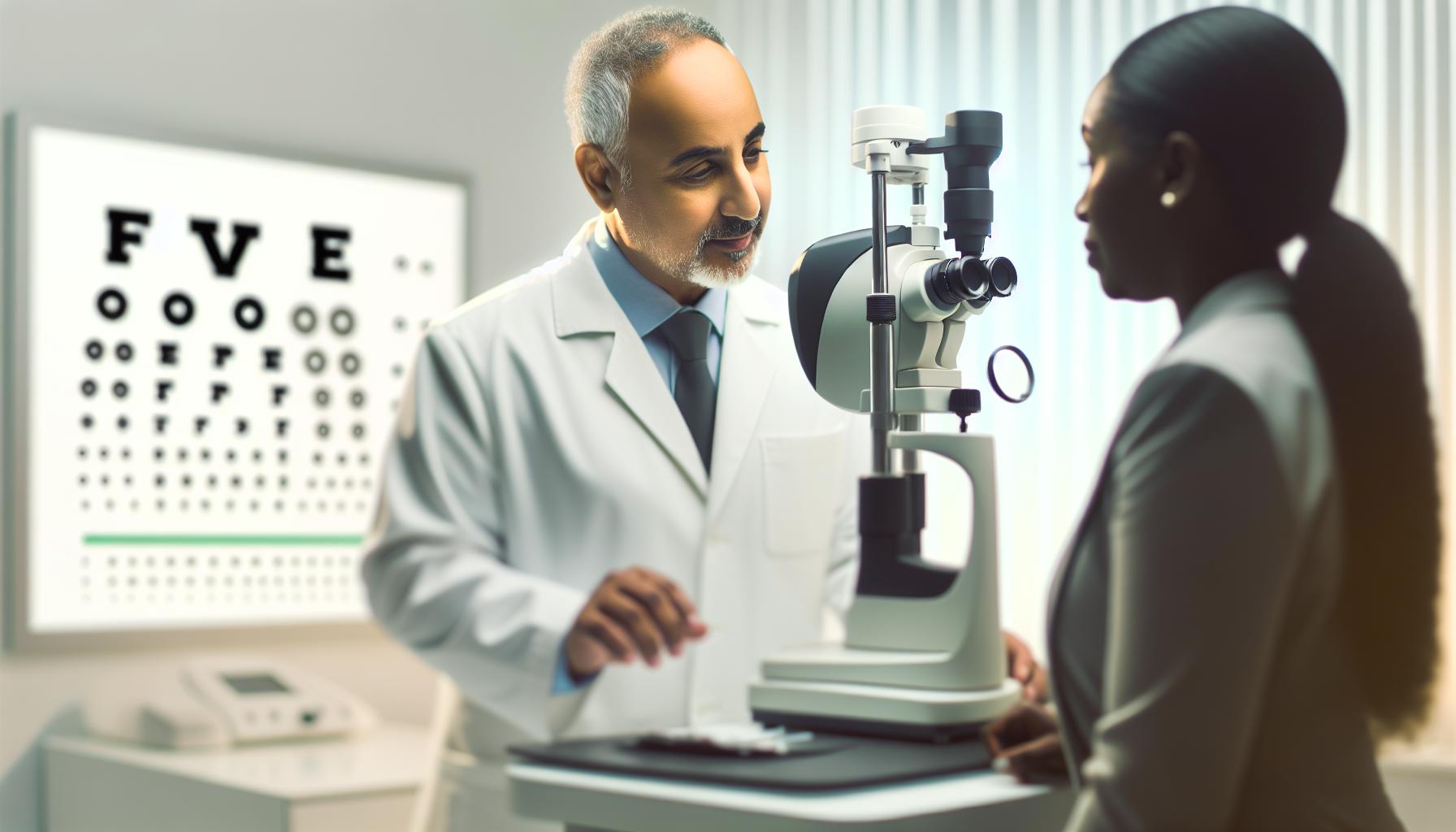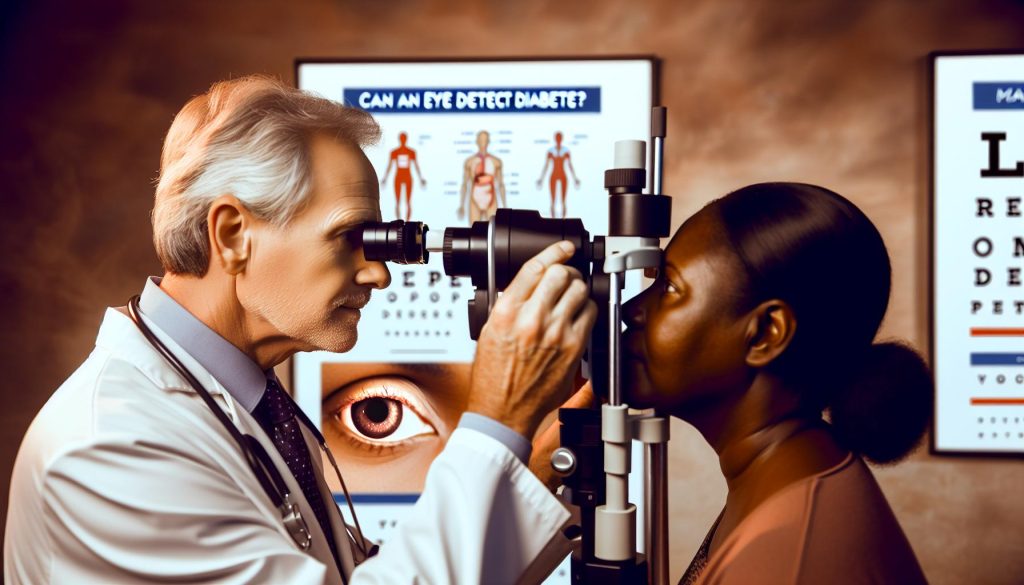Did you know that eye doctors can play a crucial role in the early detection of diabetes? In fact, during a routine eye exam, your eye doctor can spot signs of diabetes before you’re even aware of them. This makes regular eye check-ups not just important for vision health, but essential for your overall well-being, especially if you have risk factors for diabetes. Understanding how your eyes can reveal information about your blood sugar levels empowers you to take proactive steps in managing your health. As you navigate the complexities of diabetes management-balancing food choices, medical care, and lifestyle considerations-knowledge is your best ally. This article will explore how an eye exam can provide valuable insights into your diabetes risk and management, helping you on your journey to a healthier life. So, let’s dive into what your eyes may reveal about your health and how staying informed can make a difference.
Can Eye Exams Reveal Early Signs of Diabetes?

Routine eye exams can play a critical role in uncovering potential signs of diabetes long before symptoms become apparent. Studies have shown that specific changes in the blood vessels of the retina can indicate elevated blood sugar levels, providing eye doctors with the ability to detect diabetes in its early stages. This proactive measure can be vital for individuals who may not yet suspect they have diabetes, as early intervention is key to managing the disease effectively and preventing complications.
During an eye examination, optometrists and ophthalmologists assess the retina for conditions known as diabetic retinopathy, where damage occurs to the retinal blood vessels due to prolonged high blood sugar. This damage may manifest as microaneurysms, hemorrhages, or exudates, which might not be accompanied by noticeable symptoms right away. The health of the retina is intricately linked to systemic health, and by monitoring these changes, eye care professionals can recommend further testing or lifestyle changes aimed at managing or preventing diabetes-related health issues.
It’s essential for individuals, especially those at risk for diabetes due to family history, obesity, or sedentary lifestyle, to prioritize regular eye exams. The American Diabetes Association recommends that individuals with risk factors for diabetes begin annual eye exams when they are diagnosed, or at age 10 if they have type 1 diabetes. This vigilance can provide an opportunity to catch any early signs of diabetic complications, allowing for timely treatment and better outcomes in managing both eye health and diabetes itself.
In summary, eye exams are not only about vision correction; they are a vital part of comprehensive health care. They can reveal early signs of diabetes, underscoring the importance of routine visits to eye care professionals as a critical element of overall health management.
How Diabetic Retinopathy Affects Vision

Diabetic retinopathy is a significant complication of diabetes that can profoundly affect your vision. This condition results from damage to the small blood vessels in the retina caused by high blood sugar levels over time. Unlike many eye problems, the effects of diabetic retinopathy may not be immediately noticeable, making regular eye examinations crucial for early detection and intervention.
As the condition progresses, individuals might experience a range of symptoms-from blurred or fluctuating vision to dark spots or even complete vision loss. Some specific changes that occur may include:
- Microaneurysms: These are tiny bulges in the blood vessels of the retina that can leak fluid, leading to swelling and potentially distorting vision.
- Hemorrhages: Small blood vessels may burst, causing bleeding in the retina, which can appear as dark spots in your field of vision.
- Exudates: These are yellow-white patches in the retina that can represent leaks from blood vessels, affecting your visual clarity.
If left untreated, diabetic retinopathy can advance to more severe stages, where retinal detachment and vision loss may occur. Eye care professionals utilize specialized tests, such as retinal imaging, to identify subtle changes early on, enabling timely treatment options that can significantly mitigate the risk of vision loss.
To empower yourself in managing diabetic retinopathy, it’s essential to maintain good blood sugar control through regular exercise, a balanced diet, and medication adherence. Additionally, establishing a dialog with your ophthalmologist about your specific risk factors and symptoms can foster a proactive approach to your eye health. Regular screenings not only help detect diabetic retinopathy but can also lead to crucial lifestyle adjustments and medical referrals that keep your overall health in check.
The Connection Between Eye Health and Blood Sugar Levels
The eyes are often referred to as the “windows to the soul,” but they also serve as a crucial indicator of one’s overall health, particularly when it comes to blood sugar levels. Elevated glucose levels can lead to severe complications, including various eye conditions. A fascinating fact is that eye healthcare professionals can often unveil hidden signs of diabetes during a thorough examination, even before other symptoms become apparent. By monitoring eye health, patients can gain valuable insights into their blood sugar management and overall diabetes control.
Blood sugar levels have a direct effect on the health of blood vessels throughout the body, including those in the eyes. High glucose levels can cause damage to the delicate capillaries in the retina, a condition known as diabetic retinopathy. This damage often starts with mild changes that may not be noticeable to the individual but can progressively worsen, leading to significant vision impairment. Maintaining consistent blood sugar levels is essential not only for preventing these complications but also for sustaining good eye health. Regular eye examinations allow professionals to detect early signs of elevated blood sugar, such as microaneurysms, which are small outpouchings in the retinal blood vessels-critical indicators for diabetes management.
Taking a proactive approach to your eye health can significantly empower those living with diabetes. By keeping blood sugar levels well-managed through proper nutrition, exercise, and medication adherence, individuals can not only protect their vision but also improve their overall quality of life. Furthermore, incorporating regular eye exams into one’s healthcare routine serves as a holistic strategy for monitoring and managing diabetes. During these appointments, eye doctors can provide personalized recommendations tailored to individual health needs, reinforcing the notion that eye health is intricately linked to effective diabetes care.
Ultimately, it’s essential to recognize the symbiotic relationship between eye health and blood sugar levels. This connection underscores the importance of regular eye examinations in individuals at risk for diabetes or those already diagnosed. Engaging in thorough discussions with healthcare providers about eye health can foster informed decision-making and encourage a proactive attitude toward managing diabetes. With each visit to the eye doctor, patients not only safeguard their vision but also take crucial steps toward comprehensive health management.
What Specific Changes Can Eye Doctors Detect?

Eye exams serve as vital checkpoints for many aspects of health, particularly when it comes to diagnosing conditions like diabetes. The subtle changes in the eye can reveal a wealth of information about an individual’s blood sugar levels and the potential for diabetes-related complications. For instance, during a comprehensive eye examination, professionals look for distinct alterations in the retina that can indicate elevated blood glucose levels, often before other symptoms of diabetes appear.
One primary change that eye doctors look for is the presence of microaneurysms – tiny bulges in the walls of the retinal blood vessels. These microaneurysms can be the first signs of diabetic retinopathy, a common eye condition linked to diabetes. Eye professionals also assess the condition of the blood vessels themselves. Leaking fluid, hemorrhages, or excessive growth of new blood vessels (neovascularization) can indicate that the body’s blood sugar levels have been poorly controlled over time. Such early detection can prompt timely interventions to prevent further complications, ultimately helping to preserve vision.
In addition to analyzing blood vessels, eye doctors may observe the thickness of the retina and the overall health of the optic nerve. Changes in the retinal nerve fiber layer can reveal how well the eye is handling the stress of elevated blood sugar levels. This layer may become thinner due to damage, offering the eye care provider a glimpse into how severely blood sugar fluctuations have affected the individual’s health.
Regular eye exams not only allow for the early identification of diabetes but also serve as an important opportunity to discuss lifestyle changes that can improve overall health. Eye specialists can recommend tailored strategies for managing blood sugar levels through diet, exercise, and adherence to medication plans. Engaging with qualified professionals during these appointments encourages a proactive approach to both eye health and diabetes management, helping patients feel empowered in their daily choices and healthcare decisions.
Understanding Eye Tests Used to Diagnose Diabetes

Eye examinations are crucial not only for maintaining overall vision health but also for detecting early signs of diabetes. A comprehensive eye test can serve as a window into your systemic health, revealing important insights that may often go unnoticed until serious complications arise. During these exams, eye care professionals utilize a variety of specialized techniques to assess the state of the retina, optic nerve, and surrounding structures, which can signal underlying issues with blood sugar regulation.
One of the primary tools used in diagnosing diabetes-related conditions is dilated fundus examination. In this process, eye doctors apply eye drops to dilate the pupils, allowing for a clear view of the retina and blood vessels at the back of the eye. They inspect the retina for signs such as microaneurysms, hemorrhages, and abnormal blood vessel growth-each of which can indicate diabetic retinopathy or reveal troubling blood sugar levels. By identifying these changes early, eye care providers can recommend timely lifestyle adjustments or medical interventions aimed at controlling diabetes and preventing vision loss.
Another essential test in the arsenal of eye examinations is optical coherence tomography (OCT). This non-invasive imaging technique offers cross-section images of the retina, enabling eye care providers to evaluate the thickness and integrity of the retinal layers. A thinning of the retinal nerve fiber layer or changes in the retinal structure can illuminate how well an individual’s body is coping with elevated glucose levels. Such detailed imaging provides valuable information that can inform discussions about diabetes management and has the potential to prevent further complications.
Preparing for an eye examination is vital for maximizing its effectiveness. Individuals with diabetes should inform their eye doctor about their medical history, current medications, and any changes in vision or symptoms they may have experienced. This information provides context for the eye care provider, ensuring a thorough evaluation tailored to the patient’s unique health needs. Regular eye exams, ideally conducted on an annual basis or as recommended by healthcare professionals, are key to not only diagnosing potential diabetes-related complications but also fostering continuous dialogue about lifestyle choices that can help stabilize blood sugar levels.
With each visit, patients have the opportunity to engage actively with their eye care team, fostering a partnership in managing diabetes. This holistic approach empowers patients to take charge of their health, making informed decisions about daily management, nutrition, and necessary referrals to specialists. Regular communication with qualified professionals can profoundly impact not just eye health but overall diabetes management, ultimately enhancing quality of life.
How to Prepare for an Eye Examination for Diabetes
To make the most of your eye examination, especially when managing diabetes, preparation is key. Such exams not only assess vision health but also serve as critical checkpoints for detecting potential diabetes complications. Being well-prepared can ensure a more thorough evaluation and fruitful discussions about your overall health and diabetes management.
Prior to your appointment, gather important medical information. This includes a list of your current medications, any recent changes in your diabetes management regimen, and your latest blood sugar readings. If you have experienced any new symptoms, such as blurred vision or changes in your eyesight, jot those down as well. It’s important to communicate how your diabetes is currently being managed, as this context enables eye care professionals to tailor their examination and recommendations effectively.
On the day of your examination, consider a few practical steps. It’s wise to wear clothing that is comfortable, as some exams may take a bit of time, especially if dilating eye drops are used. You might also want to arrange for someone to accompany you to the appointment. The effects of dilating drops can impair your vision temporarily, making it challenging to drive afterward. Having a friend or family member with you can help ease any anxiety and ensure you return home safely. If you wear glasses or contact lenses, bring them along to facilitate a comprehensive evaluation.
If you’re looking to take an active role in your diabetes management, bring along questions for your eye doctor. For example, ask about the specific changes they will be looking for in your eyes that relate to diabetes, how often you should schedule follow-up appointments, or any lifestyle adaptations that can help protect your eyesight. Engaging in this dialogue not only empowers you but also fosters a collaborative relationship with your healthcare team. Through consistent check-ins, you’ll be better equipped to navigate daily health decisions, understand your condition, and take proactive steps to protect your vision and overall well-being.
When to Schedule Your Eye Exam: Guidelines for Diabetics
Regular eye examinations are essential for individuals with diabetes, as they can help detect complications early, significantly improving management and outcomes. The American Diabetes Association recommends that adults with diabetes have their eyes examined at least once a year. However, the specific scheduling may depend on individual health factors, such as the duration of diabetes, control of blood sugar levels, and the presence of any diabetes-related complications.
For those newly diagnosed with type 1 diabetes, the first eye exam should occur about five years after the diagnosis. For individuals with type 2 diabetes, an eye exam should ideally take place shortly after diagnosis and then annually. If your eye care provider identifies any issues or if there are significant fluctuations in your blood sugar levels, they may suggest more frequent check-ups. This proactive approach not only aids in the early detection of conditions like diabetic retinopathy but also allows for timely intervention and management.
It’s also important to be mindful of changes in your vision that may signal the need for an additional appointment outside of your regular annual examination. Symptoms such as sudden visions changes, floaters, or blurriness should prompt immediate consultation with your eye doctor. Additionally, during any routine check-ups with your primary care provider, ensure to discuss your eye health and confirm the need for an eye appointment, especially if you’ve experienced recent changes in your diabetes management.
By prioritizing regular eye exams and maintaining open communication with your healthcare team, you empower yourself to take an active role in managing your diabetes and protecting your eye health. Always remember, early detection and intervention are vital in preventing more severe complications down the road.
The Role of Optometrists in Diabetes Management
Maintaining optimal eye health is a vital yet often overlooked component of diabetes management. Optometrists play a crucial role in this process, not only by detecting early signs of diabetes-related complications but also by providing actionable advice on how to protect vision and eye health over time. Their expertise goes beyond just vision correction; they serve as essential partners in the overall healthcare team that supports diabetes management strategies.
Understanding Diabetic Effects and Monitoring
For individuals living with diabetes, the eyes can serve as windows to potential health issues. Optometrists are trained to recognize the subtle changes in the eyes that may indicate fluctuating blood sugar levels or complications like diabetic retinopathy. Regular eye examinations can reveal early signs of these conditions, enabling timely interventions that can preserve vision. During a comprehensive eye exam, optometrists will utilize advanced imaging technology to track changes in the retina, providing valuable data that helps manage an individual’s overall health.
Moreover, these specialists can educate patients about the link between eye health and blood sugar levels. They often provide tailored advice on lifestyle changes that can help stabilize blood glucose, such as dietary adjustments and exercise. For instance, understanding how certain foods may impact blood sugar levels allows patients to make informed choices that can subsequently improve eye health.
Holistic Diabetes Care and Referrals
Optometrists also serve as a crucial referral point within the healthcare system. If they identify any concerning changes in a patient’s eyes, they can promptly refer them to an endocrinologist or a diabetes specialist for further evaluation. This collaborative approach is vital for effective diabetes management. For instance, if an optometrist observes signs of diabetic retinopathy, which could lead to severe vision loss if untreated, timely referral can be life-saving.
Additionally, optometrists often encourage questions and active participation from their patients. Patients should feel empowered to ask their eye doctor about any concerning symptoms or changes in their vision, such as blurriness or difficulty seeing at night. Open communication can bridge gaps in understanding and foster a patient-centered approach to managing diabetes and its complications.
In summary, optometrists are not just providers of corrective lenses; they are essential allies in the fight against diabetes-related eye complications. Through regular exams, education, and interdisciplinary collaboration, they help patients navigate the complexities of diabetes management while ensuring that eye health remains a priority. By maintaining regular appointments with your optometrist and actively engaging in your own health decisions, you can work towards preserving both your vision and overall well-being.
Lifestyle Tips for Protecting Your Eyes From Diabetes
Taking proactive steps to protect your eye health can significantly impact your overall well-being, especially if you’re living with diabetes. Maintaining stable blood sugar levels is crucial, as fluctuations can lead to serious eye conditions such as diabetic retinopathy, which can compromise your vision. Here are some practical lifestyle tips that can help safeguard your eyes and support your diabetes management.
Nutrition and Diet
A balanced diet rich in nutrients can help control blood sugar levels and promote eye health. Focus on incorporating foods high in antioxidants, such as leafy greens, berries, and fish rich in omega-3 fatty acids. These nutrients may help reduce inflammation and protect the retina from damage. Consider making the following dietary choices:
- Choose whole grains: Foods like brown rice, quinoa, and whole oats can help maintain steady blood sugar levels.
- Limit sugar and refined carbs: Minimize your intake of sugary snacks and processed foods that can cause spikes in blood glucose.
- Stay hydrated: Drinking plenty of water is essential for overall health and can help your body manage blood sugar effectively.
Regular Physical Activity
Engaging in regular physical activity is not just beneficial for overall health; it plays a vital role in diabetes management. Exercise can help regulate blood sugar levels, which in turn can reduce the risk of diabetic eye complications. Aim for at least 150 minutes of moderate-intensity aerobic activity each week, such as brisk walking or cycling. Additionally, consider incorporating strength training exercises twice a week to enhance overall fitness.
Consistent Monitoring and Eye Exams
Keep up with your diabetes management by regularly monitoring your blood sugar levels. This consistency will enable you to make informed choices about your diet and exercise, ultimately affecting your eye health. Don’t forget the importance of regular eye examinations. Optometrists can detect changes early, giving you the chance to manage any developing issues proactively.
If you experience any concerning symptoms, such as blurred vision or difficulty seeing at night, don’t hesitate to consult your eye doctor. Open communication is key; don’t hesitate to ask your healthcare team any questions you may have regarding your eye health or diabetes management.
By adopting these lifestyle strategies, you empower yourself to take charge of your diabetes and eye health. Incorporating healthier choices can lead to significant improvements in your overall health and well-being, enabling you to live a fuller, more vibrant life.
Exploring the Impact of Diabetes on Eye Conditions
Diabetes isn’t just a condition that affects blood sugar levels; it can also lead to serious complications in various parts of the body, particularly the eyes. One striking fact is that diabetes is a leading cause of blindness among adults. Monitoring eye health is crucial, as early signs of complications can often be detected before symptoms become severe. Understanding how diabetes impacts eye conditions helps empower individuals to take proactive steps towards maintaining their vision.
Diabetic retinopathy is one of the most common eye conditions resulting from diabetes. It occurs when high blood sugar levels damage the blood vessels in the retina, leading to vision problems. The early stages of diabetic retinopathy often present no symptoms, making regular eye exams vital for early detection. Optometrists can identify specific changes in the retina, such as microaneurysms and macular edema, which may signal the onset of this condition. By diagnosing it early, patients can implement strategies to manage their diabetes more effectively and potentially avert major vision loss.
Another condition to be aware of is diabetic macular edema, which can develop from diabetic retinopathy. This occurs when the macula, the part of the retina responsible for sharp vision, swells due to fluid leakage, resulting in blurred or distorted vision. Timely intervention through eye exams can lead to treatments like laser therapy or injections that aid in managing this condition.
Eye conditions linked to diabetes extend beyond retinal issues. Patients might also experience cataracts, where the lens of the eye becomes cloudy, and glaucoma, which causes increased pressure in the eye. Those with diabetes are at a higher risk for developing these conditions, making comprehensive eye care essential. Regular check-ups with an eye care professional will ensure timely detection and management of these potential issues.
Taking steps to protect eye health can significantly enhance quality of life for individuals living with diabetes. Regular communication with your healthcare team, including eye care providers, is paramount. Equip yourself with questions about your eye health and the implications of your blood sugar control. By staying informed and proactive, you can effectively navigate the challenges that diabetes presents to your eye health.
Signs You Shouldn’t Ignore: Eye Symptoms Related to Diabetes
Diabetes is often called a “silent disease” because many individuals may not recognize its onset until serious complications occur. However, your eyes can provide critical clues about underlying diabetes. Being attentive to the visual signs that might indicate diabetic complications is essential for preserving your vision and overall health. Early detection through eye exams can significantly alter outcomes, allowing for timely intervention and management.
Certain eye symptoms should raise immediate concern. For instance, blurred vision can signal fluctuations in blood sugar levels, particularly if you experience rapid changes that come and go. Similarly, the appearance of floaters-tiny spots or lines that drift across your field of vision-can be an early indicator of diabetic retinopathy, where the retina’s blood vessels begin to leak or swell. Dark or shadowy areas in your vision should not be ignored either, as they may suggest potential issues with the macula, crucial for sharp, central vision.
Moreover, difficulty perceiving colors could be another sign of diabetic changes in the eye. If you notice that colors appear dull or muted, this could be linked to damage in your retinal cells. Eye pain or discomfort, while common for various reasons, becomes particularly concerning if linked with other symptoms of diabetes or fluctuating sugar levels.
Maintain open lines of communication with your healthcare team. Regularly scheduled eye exams are crucial; they allow your optometrist to observe changes in your retina or the structure of your eyes and address issues before they progress. Be proactive-conducting regular self-checks and seeking immediate care if you experience any of these symptoms can make all the difference in managing your eye health effectively. Empower yourself with knowledge and ensure that you take every necessary step to protect your vision and overall well-being.
Empowering Patients: Questions to Ask Your Eye Doctor
Understanding your eye health is crucial, especially for individuals with diabetes or those at risk. Proper communication with your eye care provider can significantly enhance your understanding of how diabetes may impact your eyes and overall vision. Here are some essential questions to consider when you visit your eye doctor.
Key Questions to Ask Your Eye Doctor
- What signs of diabetes should I look for in my eyes? Ask your doctor about specific symptoms that might indicate diabetes, such as changes in vision or eye discomfort.
- How often should I get my eyes checked? Regular eye exams are vital for early detection and management of diabetic eye conditions. Your doctor can recommend an appropriate schedule based on your individual risk factors.
- What tests will you perform to check for diabetic retinopathy? Understanding the specific tests (like retinal imaging or dilated eye exams) can help you feel more prepared and informed about the process.
- How can my blood sugar control impact my eye health? Discussing the relationship between blood sugar levels and eye conditions will clarify how lifestyle changes, diet, and medication can help protect your vision.
- What treatment options are available if I have diabetic eye disease? It’s essential to know your treatment choices if diagnosed with conditions like diabetic retinopathy or cataracts, including lifestyle modifications and medical interventions.
- Are there specific lifestyle changes I should make to protect my eyes? Inquire about habits or adjustments, such as nutrition or exercise, that can benefit not only your eye health but also your overall diabetes management.
- What resources do you recommend for further education on diabetes and eye health? Your doctor may provide access to valuable resources that can empower you with knowledge for better self-management.
Effective communication with your eye care provider is key to navigating the relationship between diabetes and vision health. By asking these targeted questions, you can gain valuable insights and take proactive steps to safeguard your eyesight. Always remember that while information from healthcare providers is critical, managing diabetes is a partnership that includes you and your entire healthcare team.
Q&A
Q: Can an eye exam detect early signs of diabetes?
A: Yes, an eye exam can reveal early signs of diabetes. Eye doctors can identify changes in the retina and blood vessels that indicate high blood sugar levels. Regular eye exams are crucial for early detection of diabetes-related issues, allowing for prompt management.
Q: What symptoms in the eyes indicate diabetes?
A: Symptoms such as blurred vision, floaters, or sudden vision loss can indicate diabetes. These may be signs of diabetic retinopathy, a serious condition caused by high blood sugar damaging blood vessels in the eye. If you notice any of these symptoms, consult your eye doctor immediately.
Q: How often should diabetics have eye exams?
A: Diabetics should have annual eye exams, or more frequent visits if recommended by their eye doctor. Regular examinations help monitor eye health and detect any diabetes-related changes early, ultimately preventing vision loss.
Q: What other health conditions can an eye exam reveal?
A: Eye exams can detect various health conditions like hypertension, high cholesterol, and autoimmune diseases. The blood vessels and nerves in the eyes may reflect systemic diseases, making eye exams valuable for overall health assessment.
Q: How do eye doctors examine for diabetes?
A: Eye doctors use various tests, including retinal photography, optical coherence tomography (OCT), and dilation of pupils to examine the retina thoroughly. These tests help identify any changes linked to diabetes and assess overall eye health.
Q: Can vision problems from diabetes be reversed?
A: Some vision problems caused by diabetes, such as early-stage diabetic retinopathy, can be managed or even reversed with proper treatment, including laser therapy and strict blood sugar control. Early intervention is vital for preserving vision.
Q: What lifestyle changes can help protect my eyes if I have diabetes?
A: Maintaining a healthy diet, controlling blood sugar levels, quitting smoking, and exercising regularly can help protect eye health in diabetics. Regular check-ups with an eye doctor are also essential for early detection and management of complications.
Q: What questions should I ask my eye doctor about diabetes and my eye health?
A: Ask about the results of your eye exam, potential risks based on your medical history, what symptoms to watch for, and the appropriate frequency of future eye exams. Understanding your eye health is crucial in diabetes management.
For more insightful information on managing diabetes and its effects on eye health, check the article’s sections, such as “The Connection Between Eye Health and Blood Sugar Levels” and “Lifestyle Tips for Protecting Your Eyes From Diabetes.” Exploring these topics can empower you in your diabetes journey.
In Summary
Understanding that an eye examination can reveal crucial insights into your overall health, particularly the risk of diabetes, empowers you to take action. Don’t wait-schedule your eye exam today to ensure early detection and better management of your health. For more information on effective diabetes management, check out our guides on daily care and lifestyle choices, or explore how to make healthier food selections that could benefit your well-being.
If you have questions or personal experiences related to diabetes detection or management, we invite you to share them in the comments below. Your insights could help others! Also, consider subscribing to our newsletter for the latest updates and resources that can support you and your loved ones in navigating diabetes management confidently. Remember, effective management starts with the right information-let’s continue this journey together!












